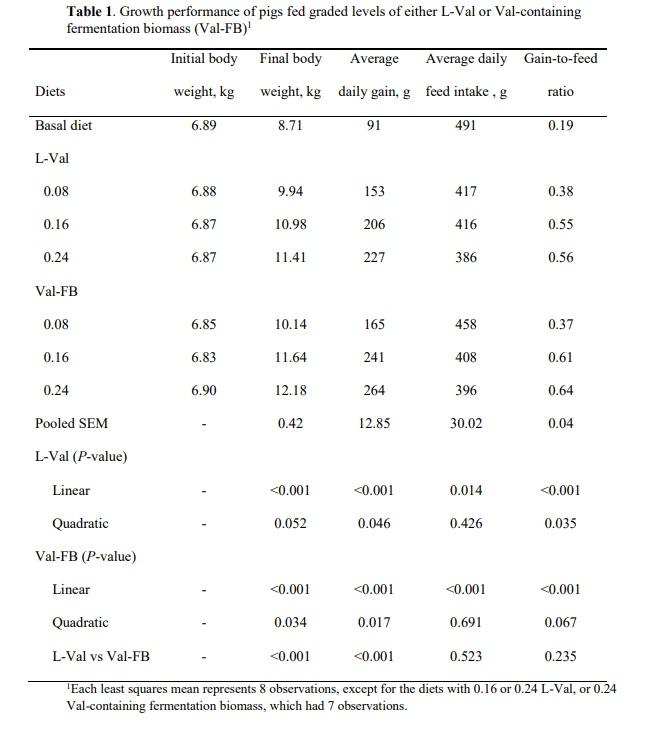
Content sponsored by:
Evonik Animal Nutrition
Bioavailability of valine in a fermentation biomass product relative to the bioavailability in crystalline L-valine when fed to weanling pigs
Published: March 20, 2019
By: M. S. F. Oliveira¹, J. K. Htoo², J. C. González-Vega², J. E. Thomson³, H. H. Stein¹.¹University of Illinois at Urbana-Champaign, Urbana, ²Evonik Nutrition & Care GmbH, HanauWolfgang, Germany, ³Hamlet Protein, Canton, Georgia.
Keywords: bioavailability, valine, performance.
An experiment was conducted to test the hypothesis that Val from a Val-containing fermentation biomass product (Val-FB; 64.4% L-Val) has a bioavailability of 100% relative to L-Val (98% Val) when fed to weanling pigs. A Val-deficient basal diet containing 0.63% standardized ileal digestible (SID) Val was formulated. Six additional diets were prepared by supplementing the basal diet with 0.08, 0.16, or 0.24% L-Val or 0.12, 0.25, or 0.37% Val-FB to create experimental diets containing 0.71, 0.79, or 0.87% SID Val. A total of 224 weanling pigs (6.87 ± 0.64 kg) were allotted to a randomized complete block design with 7 diets and 8 replicate pens per diet. Diets were fed for 21 d and growth performance was measured on a pen basis. Orthogonal-polynomial contrasts were used to determine linear and quadratic effects of L-Val and Val-FB levels on performance and the effect of Val sources. A linear regression model based on performance was used to estimate the relative bioavailability (RBV) of Val in Val-FB relative to L-Val. The final body-weight (BW) and average-daily-gain (ADG) were greater (P < 0.01) for pigs fed diets supplemented with Val-FB than pigs fed diets supplemented with L-Val (Table 1). The average-daily-feed-intake (ADFI) decreased linearly (P < 0.01), whereas gain-to-feed ratio (G:F) increased (P < 0.01) by supplementing graded levels of both Val sources to the diets. The RBV of Val in Val-FB as determined by ADG, G:F, and final BW was 146, 135, and 143%, respectively, with 95% confidence intervals of 99 to 191%, 83 to 187%, and 70 to 217%, respectively. In conclusion, the linear regression estimated a RBV of at least 100% for Val-FB relative to L-Val, and pigs fed diets supplemented with Val-FB had greater ADG and final BW than pigs fed diets supplemented with the same amount of L-Val.

Content from the event:
Related topics:
Authors:
Evonik Animal Nutrition
Cargill
Recommend
Comment
Share

Would you like to discuss another topic? Create a new post to engage with experts in the community.


.jpg&w=3840&q=75)